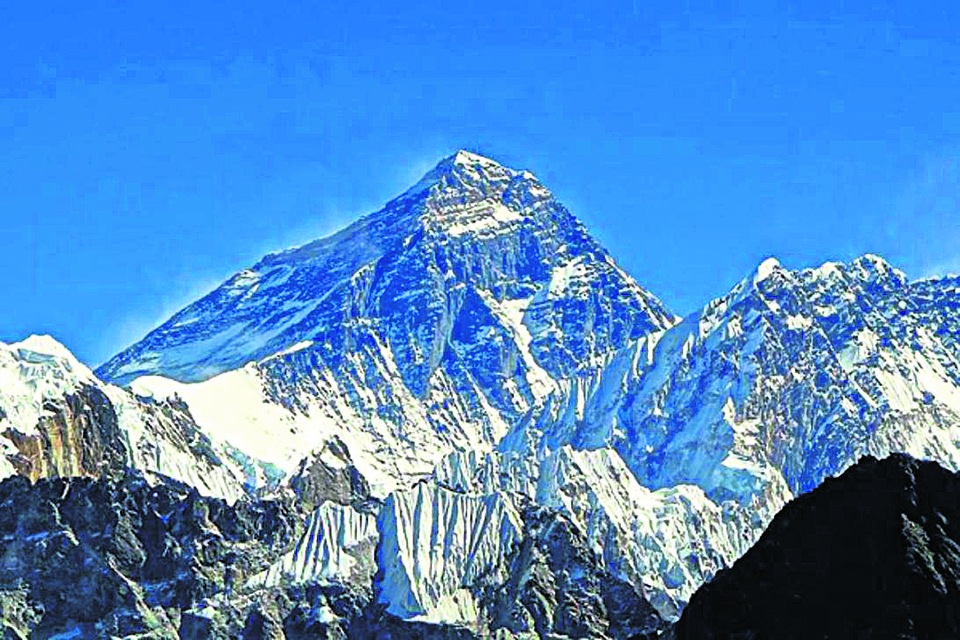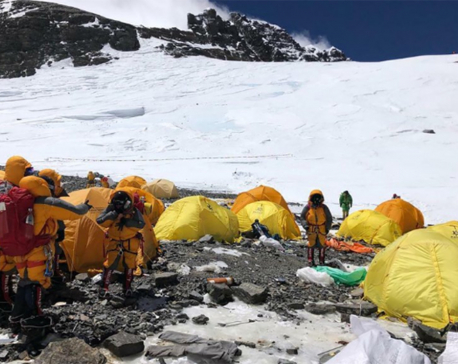
OR
National Geographic installs weather stations on Everest
Published On: June 14, 2019 04:30 AM NPT By: Republica | @RepublicaNepal

KATHMANDU, June 14: National Geographic Society on Thursday announced that it successfully installed the world's two highest operating weather stations on Mt Everest aimed at breaking new ground in monitoring and understanding of climate change.
An international team of scientists and climbers led by the National Geographic Society and Tribhuvan University conducted a scientific expedition to Mt Everest, believed to be the most comprehensive single scientific expedition to the mountain in history.
The multidisciplinary team installed the two highest weather stations in the world (at 8,430 meters and 7,945 meters), collected the highest-ever ice core sample (at 8,020 meters), conducted comprehensive biodiversity surveys at multiple elevations, completed the highest-elevation helicopter-based lidar scan, expanded the elevation records for high-dwelling species and documented the history of the mountain's glaciers.
Studies have shown that the glaciers of the Hindu Kush–Himalaya, where Mount Everest is located, are rapidly disappearing due to increasing global temperatures. The extreme conditions of high-elevation mountain ranges have made studying the true impacts of climate and environmental changes nearly impossible. As a result, there are critical knowledge gaps about the history of these glaciers and about future impacts that their disappearance would have on the lives and livelihoods of the more than one billion people in the region who depend on the reliable flow of water these glaciers provide.
“Climate change is one of the biggest challenges facing humanity and there is still much to learn about how it's already altered the world, from the deepest parts of the ocean to its tallest mountains,” said Jonathan Baillie, executive vice president and chief scientist at the National Geographic Society. “By harnessing our 131-year history of exploration and venturing into some of the most extreme environments on the planet, we will fill critical data gaps on the world's life support systems and drive solutions to assure that they can continue to fuel our future.”
With team members from eight countries, including 17 Nepali researchers, the expedition team conducted trailblazing research in five areas of science that are critical to understanding environmental changes and their impacts: biology, glaciology, meteorology, geology and mapping. Scientific results from the expedition will be analyzed and submitted for publication in the coming years, said the society in a press release issued on Thursday.The initial outcomes of the study
● Installation of the world's two highest operating automated weather stations (8,430 meters and 7,945 meters), as well as three other weather stations on Mount Everest
● Collection of the world's highest ice core (8,020 meters) and other ice cores from lower elevations
● Completion of the highest-elevation helicopter-based lidar scan
● Completion of the most detailed lidar scans and photogrammetric imaging of the Everest Base Camp area and the entire Khumbu Glacier ever completed
● Collection of water samples from seven glacial lakes for biodiversity assessment
● Collection of glacial lake sediment cores from Gokyo Valley lakes
● Surveys of biodiversity and wildlife in multiple high-elevation environments
● Installation of four biodiversity monitoring stations in the high Himalaya
You May Like This

Mysterious disease killing dogs in Norway
HELSINKI, Sept 8: Norwegian authorities haven’t been able to detect the cause behind an unexplained disease that is estimated to... Read More...

Everest region to ban plastic items below 30 microns from 2020
KATHMANDU, Aug 20: The executive council of Khumbu Pasanglhamu Rural Municipality in Solukhumbu district in the Everest region has decided to... Read More...

Smugglers’ go-downs near customs office
SIRAHA, March 16: On March 10, a team from the District Police Office (DPO), Siraha, arrested a truck with an... Read More...










Just In
- MoPIT prepares draft of National Road Safety Act, proposes rescue within an hour of an accident
- Light rainfall likely in hilly areas of Koshi, Bagmati, Gandaki and Karnali provinces
- Customs revenue collection surpasses target at Tatopani border, Falls behind at Rasuwagadhi border in Q3
- Rain shocks: On the monsoon in 2024
- Govt receives 1,658 proposals for startup loans; Minimum of 50 points required for eligibility
- Unified Socialist leader Sodari appointed Sudurpaschim CM
- One Nepali dies in UAE flood
- Madhesh Province CM Yadav expands cabinet









Leave A Comment